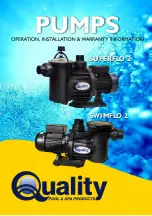
Installation, Operating and Maintenance Instruction
Model TVS
TVS 100-english
page 33
Revision 04
Article No 771072023
Issue 01/2011
1,0
10,0
100,0
1
10
100
1000
Motor power [kW]
m
ax
. p
er
m
. s
ta
rt
s/
h
Diagram 1
If two different figures are given, the lower figure is
valid.
6.3 Shutting down
Close the valve in discharge pipe right before
(max. 10 seconds) switching off the motor. This is
not necessary if there is a spring-loaded check
valve.
Switch off motor (make sure it runs down quietly).
7. Maintenance, Servicing
Work should only be carried out on the pump or
pump unit when it is not in operation. You must
observe Point 1.4 "Safety instructions".
Maintenance and servicing work must only be
carried out by trained, experienced staff who
are familiar with the contents of these Operating
Instructions, or by the Manufacturer's own
service staff.
The submersible pump requires virtually no
maintenance. Inspection work is limited to the
periodical measuring of insulating resistance (once a
month when the motor is cold) as well as regular
checking
of
the
operating
voltage,
current
consumption and the flow data. We recommend that
you record and compare these data in the "Log Book".
The development of this data can perhaps make it
possible to recognize damage early on thus making it
possible to avoid greater damage or even complete
destruction.
Slow reduction of the flow rate at the same discharge
level, with normal or reduced current consumption
indicates increased wear and tear of the pump
components (e.g. through sand). A large increase or
fluctuations in current consumption indicate a
mechanical fault (e.g. increased mechanical friction
due to a defective bearing). The unit should be taken
out of operation immediately to prevent greater
damage.
The electrical devices should be inspected
annually by a specialist to see that they function
properly.
8. Longer periods of non-operation
When starting up, follow the instructions for
starting up for the first time (see Point 6)!
Check insulation resistance of installed units at
monthly intervals and carry out a short trial run to
prevent the pump part getting stuck due to sediments.
The minimum flooding of the unit must be guaranteed
during this process.
9. Faults - Causes and Solutions
The following notes on causes of faults and how to
repair them are intended as an aid to recognising the
problem. The manufacturer's Customer Service
Department is available to help repair faults that the
operator cannot or does not want to repair. For repair
and modification of the pump by the customer pay
attention to the design data of the order confirmation
as well as to point 1.2 - 1.4 of this instruction manual.
If necessary, the written agreement of the
manufacturer must be obtained.
Faults
Code no. for cause and method of repair
Motor protection switches itself off
1, 2, 10
Electricity consumption too high. Releases motor protection. 2, 3, 4, 5, 6, 7, 24
Pump does not start
2, 3, 5, 7, 8, 9, 10
Pump runs but does not transport
11, 12, 13, 14
Output too low
15, 16, 17, 18, 19, 20, 21, 22, 23
















































